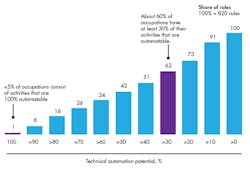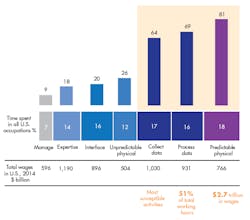Government Actions Can Help Usher in a Prosperous Automation Age
One of the greatest fears of advancing automation is the job loss that will follow. Many universities and institutions have predicted significant changes. Oxford University’s prediction is one of the direst, estimating that 47% of jobs in the United States will be automated away by 2025. Out of the 160 million jobs in the U.S., this would result in 75 million jobs lost. According a new study from the McKinsey Global Institute (MGI), the number could be as great as 73 million or as low as 39 million, depending on what actions are taken to help usher in the advances of automation.
The MGI “Jobs Lost, Jobs Gained: Workforce Transitions in a Time of Automation” report points out this is not the first time we have experienced significant job change. During the Industrial Revolution, the U.S. transitioned out of the agricultural industry. As more jobs turned towards manufacturing, the U.S. invested into secondary education and created new laws to enforce attendance. According to the report, in 1910 only 18% of children between the ages of 14 and 17 attended high school. By 1940 that number increased to 73%.
The study stresses that the prediction of 800 million jobs lost worldwide is the most extreme scenario. The more likely middle estimate is that 400 million jobs may be lost due to automation. In addition, these changes are not universal for all occupations. If the latest automation advancements became widely adopted today, only 5% of current occupations stand to be completely automated. In fact, 60% of jobs will see a third of their activities automated rather than complete job lost. And it is also important to remember that automation will be creating jobs as much as it is replacing certain tasks. While predictable physical work (such as assembly and manufacturing work) will see a 31% reduction due to automation, professions like infrastructure repair, engineers, architects, and computer engineers will see an increase of 34 to 35%.
Few occupations will be fully automatable. The research from McKinsey Global Institute shows that 60% of all occupations will see at least 30% of their tasks become automated.
What will determine how jobs fair as we transition into heavy automation, will be the steps taken by the U.S. government. The report defines key areas where action is necessary to transition us into this next phase of our labor force.
Scaling midcareer training opportunities to make lifelong learning a reality. As machines replace human tasks, new skill sets will be needed to adapt and use tools. Large-scale lifelong learning and retaining of midcareer workers will be necessary so that people can retain their jobs.
Modernizing the educational systems for the today and tomorrow’s world. Our education model is still based on 19th Century methods of teaching. Digital technologies have allowed us to create more individualized learning paths, but there are more steps that can be taken. Several countries like Germany and Switzerland use apprenticeships to approach technical skill learning. Many tertiary educational institutions have stopped focusing on the needs of the labor market. Publishing the job placement of graduates could help employers find recruits and potential students to decide their courses of studies. Finally, the government could identify and sponsor pilot programs to address known skills gaps among workers.
Expanding transition support measures for workers. Countries like Denmark, Germany, and Sweden have focused their labor agencies on reemployment and acquisition of new skills rather than unemployment benefits or controlling for fraud. A cultural shift is required that pushes workers to take a more active role in their retraining efforts. Mobility should be encouraged—not just within a country, but internationally as well. Workers who are properly educated should be able to transition into different jobs, whether they be within the country or across borders.
The graph shows the time percentage spent on activities and the percentage of time that can be automated by adapting modern automation technology.
Creating income support measures with new wage realities. With the increase of income inequality and the dawn of the new automation age, it is important to have national discussion on whether or not everyone that works can have a decent standard of living. A healthy consumer class is important for both economic growth and social stability. In other countries, income supplementation programs already exist, such as the earned income tax credit in the U.S. and universal basic income programs being tested in other countries or raising minimum wages. These incentives will be necessary to create a more stable work force.
Making job creation and worker re-deployment a national priority. An investment in human capital is necessary. Governments should be able to assess the impacts their policies and investments have on job creation. Companies need to invest in worker training and redeployment through tax and other incentives. This requires a revisit of tax codes, subsidies, support for entrepreneurship and small business, streamlining regulations,, and revisiting personal bankruptcy laws that discourage risk-taking.
Modernizing data collection for the new labor market. Governments need to modernize their census data techniques. The data collected from household surveys and employers need to be supplemented with real-time data on adoption of automation technologies, job openings, labor market dynamism, skills in demand, and how workers are coping job transitions. Better data allows government agencies to collaborate with online data sources and job board companies—like LinkedIn and private tech companies—to obtain a more accurate picture of the job market and the mobility and career moves of workers.



